FREE CAD DESIGNS ON ALL CUSTOMER JEWELRY PRODUCTS
X
CHAT
PHONE
Toll-free: 800-527-7617
Business Hours
Monday-Saturday: 9:00am-7:00pm CST
Fax: 972-233-3363
CALL USVISIT US
View products at our showroom,
or request a visit from our sales rep.
5757 Alpha Road, Ste. 505
Dallas, TX 75240
APPOINTMENTSSHIPPING AND MEMO POLICY
Orders are shipped via FedEx. Orders above $4,000 are shipped via FedEx overnight. Consignment and memo services available upon check-out page.
ABOUT CONSIGNMENTLogin or Create an Account
Welcome to the home of Authentic Gem Imports. In order to shop these products, please log in with your authorized dealer account..
Registered Customers
If you have an account with us, please log in.
New Customers
- Home »
- Diamond Melees

Asscher

Baguette Straight

Baguette Tapered

Beads

Briolette

Cushion

Emerald

Half Moon

Heart

Kite

Marquise

Oval

Pear

Princess

Radiant

Rough

Round

Slice

Square

Trapezoid

Triangular

Trillion
Average Length
Average length of each stone on its longest side, in millimeters.
Average Width
Average width of each stone on its shorter side, in millimeters.
Specialty Cut
- Brilliant
Brilliant:This technique creates triangular-shaped facets that face outwards from the center of the diamond. Most often the term is used to refer to round brilliant cuts, the most popular cut.
- European
European:Dating back to the 1800s, this cut possesses a circular girdle with a high crown, small table, and a large, flat culet. With 58 facets, it is the predecessor of today’s modern round brilliant cut.
- Flat
Flat: An unfaceted slice, disc, or similar shape.
- Grooved
Grooved:Certain shapes, particularly the princess cut, can be grooved on the edges to allow them to be "invisibly" set together (without prongs or metal in between).
- Old Miner
Old Miner:A cut dating back to the Victorian era that features a squarish girdle with gently rounded corners. Old mine cut diamonds have a high crown, a small table, and a large, flat culet..
- Rose
Rose: An antique style cut with trangular facets coming to a point (no table) and a flat bottom (no pavilion).
- Single
Single:A round cut with only 17 or 18 facets, as opposed to the brilliant's 57 or 58 facets, and is common for "melee" diamonds.
- Step
Step: A cut with rows of long, rectangular facets resembling a staircase.
- Uneven
Uneven:Diamond cut does not display symmetry, usually practiced for diamond slices or rough diamonds.
Brilliant:This technique creates triangular-shaped facets that face outwards from the center of the diamond. Most often the term is used to refer to round brilliant cuts, the most popular cut.
Melee Status
- In Stock
In Stock: Product is in-stock and ready to ship.
- Special Order
Special Order:Product can be assembled upon order.
In Stock: Product is in-stock and ready to ship.
Sievesize
Average size range of stones as determined by a standard sieve tool. A sieve is a jewelry standard tool that filters diamonds by a range of specific sizes: (+)000 to (-)75.
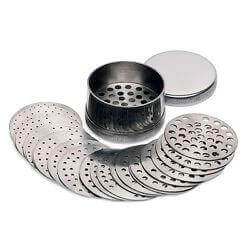
Melee Treatment
Diamonds are tested/examined for laser drilling, glass filling, surface coating, High Pressure/High Temperature (HPHT) processing, and irradiation.
HPHT: High pressure/high temperature treatment has been used to lighten, alter, or remove color from the stone.
Laser Drilled: A laser has been used to bore a very small hole into the diamond's interior to burn away a dark inclusion.
Irradiation: A genuine diamond has been exposed to high radiation to permanently shift its color to blue, green, pink, etc.
Stone Make
A description of the quality of the stone cut and polish.
Melee Description
A general description of the melee stones as determined by AGI, including a thorough grading of average cut, color and weight..
Availability
The quantity of stones available under this listing.
Avg. Weight Per Stone
Average carat weight of each stone per parcel, as determined by total carat weight divided by stone count.
Melee shape
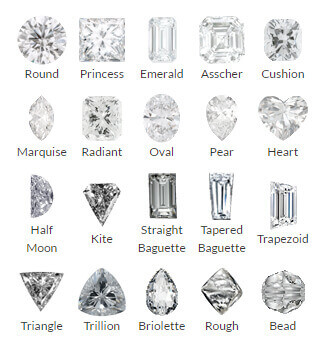
Avg No Stone Per Carat
The number of stones that would total one carat of weight
Price Per Carat
Price listed for 1 carat of stones. A common guideline used to evaluate a diamond's price. The price per carat of a diamond is affected by many factors including color, clarity, and size. Larger carat weight diamonds may have a higher price per carat because of their relative rarity compared to smaller size stones.
Average Weight
Average carat weight of each stone per parcel, as determined by total carat weight divided by stone count.
Avg Price Per Stone
Average price of each stone, as determined by total parcel weight multiplied by price per carat, then divided by stone count.
F. Instanse
Fancy Color Diamond grading rates a stone in one of nine categories based on its hue, tone, and saturation. "Tone" ranges from light to dark and "Saturation" ranges from low to high, while "Hue" refers to the diamond's general color family (yellow, pink, blue, etc.).
Availability
The quantity of stones available under this listing.
Carat (Ct)
The international unit of weight used for measuring diamonds and gemstones. 1 carat is equal to 200 milligrams, or 0.2 grams.
Fancy Color
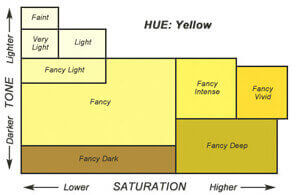
Fancy Color Diamond grading rates a stone in one of nine categories based on its hue, tone, and saturation. "Tone" ranges from light to dark and "Saturation" ranges from low to high, while "Hue" refers to the diamond's general color family (yellow, pink, blue, etc.). If you would like to learn more, visit the Gemological Insititute of America (GIA)'s page on fancy diamond color.
Brown Brown diamonds are graded on a tone and saturation scale from light champagne (C1-C2) to Cognac (C7).
Brown diamonds are graded on a tone and saturation scale from light champagne (C1-C2) to Cognac (C7).
 Brown diamonds are graded on a tone and saturation scale from light champagne (C1-C2) to Cognac (C7).
Brown diamonds are graded on a tone and saturation scale from light champagne (C1-C2) to Cognac (C7).Polish
The overall condition of a finished diamond's faceted surfaces, including how smoothly the facets have been polished, whether any marks are visible from the polishing wheel, and how defined the edges of each facet are. Polish marks are almost always invisible to the unaided eye, but good polish is essential for maximum light performance.
Symmetry
The precision and alignment of a diamond's facets and the resulting effects on its brilliance.

Depth percentage
The height of a diamond, measured from the culet to the table, divided by its average girdle diameter. One of the basic proportions that contributes to a diamond's appearance, brilliance and fire.
Table
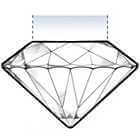
Usually the largest facet on a diamond, located on the top. The size of the table can have a considerable effect on the diamond's light performance or brilliance.
Length-to-width ratio
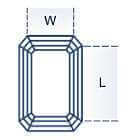
Length (L) divided by Width (W) is the Length-to-Width ratio. This conveys how relatively square or rectangular a fancy-shaped diamond appears when viewed from the top.
Ideal Length-to-Width Ratios
Asscher: 1 to 1.05
Cushion: 1 to 1.05 (square); >1.15 (rectangle)
Emerald: 1.3 to 1.4
Heart: 0.90 to 1.10
Marquise: 1.75 to 2.25
Oval: 1.33 to 1.66
Pear: 1.45 to 1.75
Princess: 1 to 1.05
Radiant: 1 to 1.05 (square); >1.10 (rectangle)
Asscher: 1 to 1.05
Cushion: 1 to 1.05 (square); >1.15 (rectangle)
Emerald: 1.3 to 1.4
Heart: 0.90 to 1.10
Marquise: 1.75 to 2.25
Oval: 1.33 to 1.66
Pear: 1.45 to 1.75
Princess: 1 to 1.05
Radiant: 1 to 1.05 (square); >1.10 (rectangle)
Fluorescence

A measure of the visible light some diamonds emit when exposed to ultraviolet (UV) rays. Diamonds with a strong or very strong fluorescence are a better value because the market prices them slightly lower. It is quite rare for fluorescence to have any visual impact on a diamond's appearance, and it does not compromise the gem's structural integrity in any way.
Cut Grade
A diamond's cut unleashes its light. Diamonds are renowned for their ability to transmit light and sparkle so intensely. We often think of a diamond's cut as shape (round, emerald, pear), but a diamond's cut grade is really about how well a diamond's facets interact with light.
Specialty Cut
- Brilliant
Brilliant:This technique creates triangular-shaped facets that face outwards from the center of the diamond. Most often the term is used to refer to round brilliant cuts, the most popular cut.
- Rose
Rose: An antique style cut with trangular facets coming to a point (no table) and a flat bottom (no pavilion).
- Step
Step: A cut with rows of long, rectangular facets resembling a staircase.
- European
European: Dating back to the 1800s, this cut possesses a circular girdle with a high crown, small table, and a large, flat culet. With 58 facets, it is the predecessor of today’s modern round brilliant cut.
- Old Miner
Old Miner: A cut dating back to the Victorian era that features a squarish girdle with gently rounded corners. Old mine cut diamonds have a high crown, a small table, and a large, flat culet.
- Single
Single: A round cut with only 17 or 18 facets, as opposed to the brilliant's 57 or 58 facets, and is common for "melee" diamonds.
- Flat
Flat: An unfaceted slice, disc, or similar shape.
- Grooved
Grooved: Certain shapes, particularly the princess cut, can be grooved on the edges to allow them to be "invisibly" set together (without prongs or metal in between).
Brilliant: This technique creates triangular-shaped facets that face outwards from the center of the diamond. Most often the term is used to refer to round brilliant cuts, the most popular cut.
Certificate
A diamond certificate, also known as a diamond report, is issued by an accredited independent gemological laboratory. In addition to the diamond's carat weight and measurements, a certificate includes grades for the diamond's cut, color and clarity.
Price
The total price of the stone found by multiplying the price per carat by the total carat weight.
Length
The measure of the longest side of the stone in millimeters.
Width
The widest point along the short side, in millimeters.
Color
- D
D color: Highest, absolutely "colorless" grade, appreciated best set in platinum or white gold. Exceptionally rare.
- E
E color: A "colorless" grade appreciated best set in platinum or white gold. Traces of color difficult for even trained eye to detect.
- F
F color: A "colorless" grade appreciated best set in platinum or white gold. Faint color detectable by a trained gemologist.
- G
G color: The highest "near-colorless" grade. Color may be detectable when compared to much higher "colorless" grades. Excellent value.
- H
H color: A "near-colorless" grade, color is only noticeable when compared to much higher color grades. Excellent value.
- I
I color: The last of the "near-colorless" grades, color may be only slightly detectable upon close examination. Exceptional value.
- J
J color: Color may be slightly detectable to the unaided eye, particularly in fancy shapes or diamonds over 1-carat.
- K-O
K-O color: Color is visibly subtle to distracting.
- P-Z
P-Z color: Color is visibly subtle to distracting.
D color: Highest, absolutely "colorless" grade, appreciated best set in platinum or white gold. Exceptionally rare.
Clarity
- IF
Flawless: No internal or external characteristics. Internally Flawless: May have external blemishes only. Both extremely rare.
- VVS1
VVS1: Very, very slightly included. Characteristics miniscule and difficult to see under 10x magnification, even to a trained eye.
- VVS2
VVS2: Very, very slightly included. Characteristics miniscule and difficult to see under 10x magnification, even to a trained eye.
- VS1
VS1: Very slightly included. Minor inclusions ranging from difficult (VS1) to somewhat easy (VS2) to see at 10x magnification.
- VS2
VS2: Very slightly included. Minor inclusions ranging from difficult (VS1) to somewhat easy (VS2) to see at 10x magnification.
- SI1
SI1: Slightly included. Inclusions noticeable at 10x. Best value if eye-clean. SI2 inclusions may be detectable to a keen unaided eye
- SI2
SI2: Slightly included. Inclusions noticeable at 10x. Best value if eye-clean. SI2 inclusions may be detectable to a keen unaided eye
- SI3
SI3: Slightly included. Inclusions noticeable at 10x. Best value if eye-clean. SI2 inclusions may be detectable to a keen unaided eye
- I1
I1: Included. Diamonds may have minor eye-visible inclusions. GIA offers a limited selection of jewelry with I1 clarity diamonds.
- I2
I2: Included. Will likely have more obvious or distracting inclusions. GIA does not carry I2-3 clarity diamonds.
- I3
I3: Included. Will likely have more obvious or distracting inclusions. GIA does not carry I2-3 clarity diamonds.
- I4
I4: Included. Will likely have more obvious or distracting inclusions. GIA does not carry I2-3 clarity diamonds.
Flawless:No internal or external characteristics. Internally Flawless: May have external blemishes only. Both extremely rare.
Eyeclean
A description of whether or not inclusions can be seen with the naked eye, expressed as 100% eyeclean, 90% eyeclean, or not eyeclean. 100% eyeclean means that inclusion(s) cannot be seen with the naked eye even after they have been located with a loupe. 90% eyeclean means the inclusion(s) are generally not seen by the naked eye and can be seen only after first locating them under a loupe.
Lab Key To Sym

The lab key to symbols for the types of inclusions shown in the stone's lab plotting diagram such as feather, cloud, cavity, pinpoint, etc. These are listed from highest to lowest impact on the stone's clarity.
Lab Certificate Comment
Additional details listed by the lab grader to describe the stone's qualities that were not covered in other sections of the lab report.
Stone Inclusion
AGI graders have carefully inspected each diamond to provide a professional description of the nature and magnitude of the stone's inclusions.
Stone Description
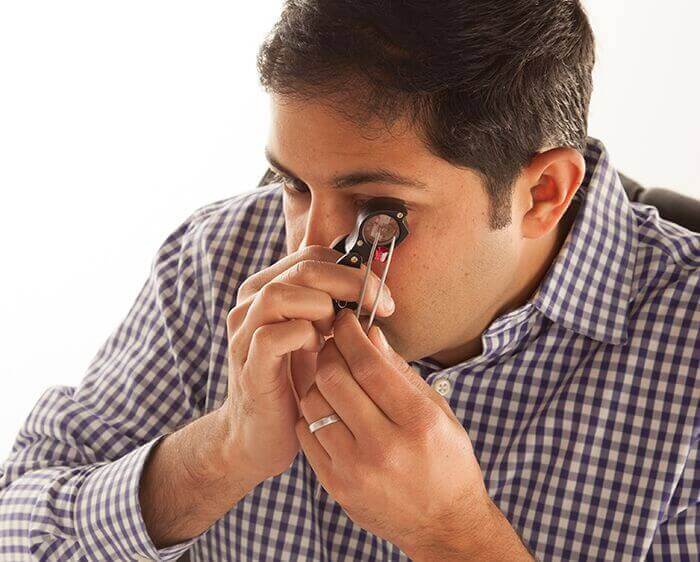
AGI's final take on the stone. AGI graders have gone the extra mile to thoroughly grade every diamond to give a professional opinion on the overall aesthetics of the stone including brilliance, bowties, cut quality, and face up coloring.
Availability
The number of stones available in this listing.
Login For Pricing
Reset Filters
Basic Search
Show Melee Filters
